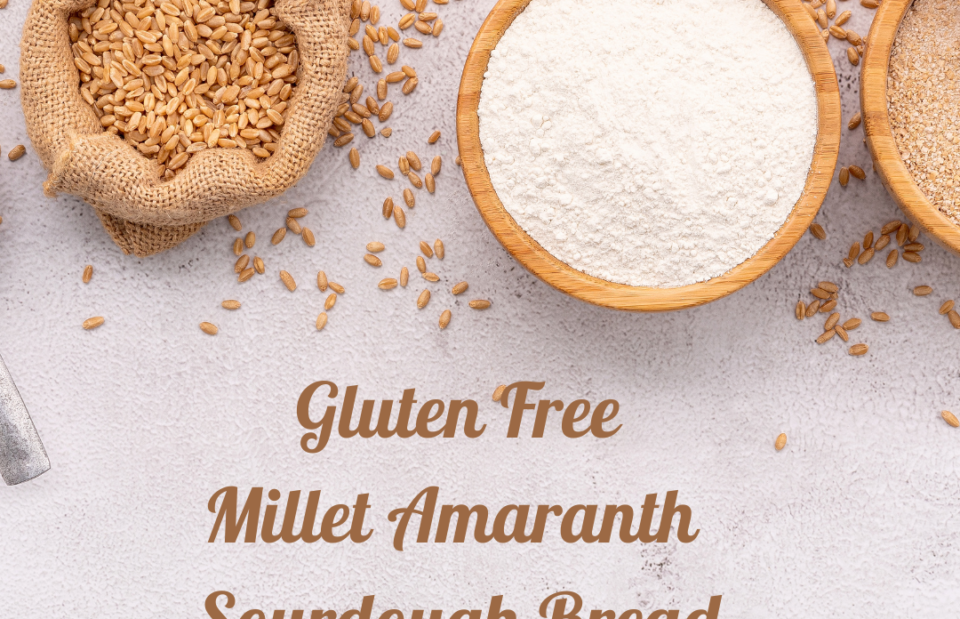When I meet a client with allergies, I want to help them find healthy substitutes for what they “think” they’ll be missing. So, naturally a whole grain sourdough comes to mind for someone with a wheat sensitivity.
The problem with premixes of gluten free flours is they are very expensive, and they are not very nutritious. I mean just reading the label shows they are refined white rice flours and starches. This is no better than refined white flour and sugar to spike blood sugar and insulin levels in the blood.
Both of which are responsible for making chronic disease and inflammation in the body worse, not better. As caring parents we can do better.

It’s an effort of love to learn how to do it, and even though I’ve played around with gluten free grains for the past twenty years, I have to admit, bread making is a learning curve.
The complexity of the flours, the binding ingredients needed, rising, and the water absorption capacity are all new factors to consider. Therefore, it makes sense to just follow a recipe, right?
LOL, I wish it were that easy for me. But it’s not. I have several varieties of grains in my pantry, and I have to make do with what I have. So, the resources I found helpful were on YouTube. Mary’s Nest has a great video that breaks down the various gluten free flours and there are several blogs that work through the water absorption.
One of the comments on Mary’s video said, “Use two parts flour to one part starch”. Now, that is something I can work with! Simple directions combined with a good resource for binding agents, and some past experience with dough consistency.
Another resource I used on YouTube was Elly’s Everyday Wholegrain, she is using millet to make her sourdough and that is the primary flour I am using today. I also have amaranth grain I want to use and some oats. The problem is I don’t have the psyllium husks and can’t find it anywhere in town.
I’m substituting ground chia seeds and flax seeds to see how it goes.
I also wanted to do a nutritional comparison of a gluten free flour blend and this wholegrain recipe to show you how we can make a healthier gluten free bread.

Gluten Free Whole Grain Sourdough
Ingredients
- 500 Grams Millet ground
- 1/2 Cup Oats
- 1/3 Cup Chia Seeds Ground
- 1/3 Cup Flax Seeds Ground
- 2 Tsps. Salt
- 1/3 Cup Arrowroot flour or potato starch
- 1/2 Cup Sourdough Starter
- 600 Grams Water
Instructions
- The Nutribullet blender with a flat blade that meals small grains very well. It worked perfect for the millet and amaranth.
- Place all the dry ingredients in a bowl and mix well.
- Add warm water and the starter and stir until well combined. Let it sit for one hour.
- After it sits one hour, you can place it in the lightly oiled baking dish of your choice. It will be sticky and loose, not well formed like a wheat dough. Don't worry about that it will set up fine. Depending on your room temperature it will take 3-6 hours to rise. On that rise it will be just slightly higher, it will not double in size, and that is ok. I put mine in the fridge overnight and it was perfectly ready the next morning.
- Preheat oven to 450 degrees. Bake the bread covered for 40 minutes and then uncovered another 15 minutes. Don't underbake this it does take just about a full hour. Let cool then, slice and enjoy!
Nutrition
Compare The Homemade Ingredients and Nutrition of the Loaf Above with a Popular Store Brand of Whole Grain Gluten Free Bread Below

Benefits and Drawbacks
The thing I love about this bread is there is 5 grams of protein and 4 grams of fiber per slice! Not only that, but there is also a good bit of potassium and iron. Although magnesium and B vitamins are not listed on the nutrition label, they’re in there, too!
The millet and amaranth (if you choose to stick that in and remove 1/3 cup of the millet) alone provide 30mg of magnesium per slice of bread. There is also biotin, niacin, and selenium present to provide optimal health.
A drawback for making this bread and what I learned is it definitely needs a long baking time. I got it out 10 minutes early and although edible, it was doughy. I’m toasting it daily on the frozen setting of my toaster to counteract that mistake. Otherwise, it would have made a great sandwich bread.
Something else I noticed; there was ZERO gas and bloating with the addition of flax seeds! That has never happened before. I may have a wheat sensitivity after all.
Taste wise, the amaranth is quite strong, so if a peppery taste is not one your palate joys, it may take some getting used to alongside the ground chia—you be the judge on that. However, I’d sample a little to see if I like the flavor before diving in to purchase the grain and make an entire loaf.
I prefer the taste of hard white and red wheat grains, but this is okay.
Cost wise, you and I come out ahead on this loaf of bread. The cost of a comparable gluten free whole grain bread on the shelf is $5.49 and I made this loaf, with twice the nutrition, for about $4.34. I’ll take that bargain any day.
When we explore new ways of baking whole grain sourdough, we find out all kinds of good things!
And may we never forget the source of all good things—the mighty God who provides these lovely nutritional grains for us! What he puts in the garden is good!







